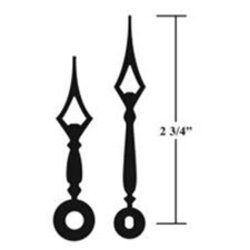Clock Hands
Exactly How to Fit Huge Clock Hands

Huge clock hands are those that are longer than around seven inches (talking the minute hand, not the hr hand). The reason large clock hands are so assigned is that lengths above that cutoff size consider excessive for a standard electric motor to turn. In other words, the common torque wants, needing the developer of the wrist watch to buy a high-torque motion instead.
Large clock hands are in theory unlimited in length, however practically talking you won't see any longer than eighteen inches, meaning that the equivalent clock would certainly go to least a yard in diameter. Even after that, the likeliest application for such a watch would be something mounted directly to the wall surface (utilizing the wall surface as the dial, in a manner of speaking) without being enclosed in a case.
Manufacturers have to tune to the sweet place on the market, as well as for clocks that suggests diameters ranging from a few inches to concerning ten to twelve inches. For this reason, clock movements (or motors) are provided with just adequate power to turn any kind of and all hands falling in this variety. This permits the producer to make simply two versions of each activity, one with standard torque and also one with high torque.
As one might visualize, higher torque demands much more power, which will certainly drain pipes the battery quicker. In turn, this implies that the batteries have to be replaced more frequently. Naturally, the product made use of to make the hand is likewise an element because not all materials have the same density or weight.
To put it simply, boosting the torque generated by a clock motion is a primary means of suiting big hands. But one does not need to just put up with these parts in order to utilize them to inform the correct time. We can likewise accommodate them stylistically to help with integrating them with the setup in which they are positioned.
Without a doubt, one shouldn't ignore the advantages reaped from ensuring that every one of the timepiece elements are working together in harmony. High contrast between the dial background and also the numbers and hands superimposed on it minimizes eyestrain and also simplifies a fast read of the time. This makes sure that your clock exhibits good functionality.
Yet design is additionally important, and also one should make every effort to accomplish a unified appearance as well as compatibility. The designs for the dial and also hands definitely don't need to equal, yet they need to be corresponding. Each component has a declaration to make; the hands and also dial don't require to duplicate the same declaration, yet they should not clash or argue with each other either.
In the larger dimensions, clock hands are rather restricted in the selection of forms (whereas the selection of sizes is ample). You can get a slim bar or a straightforward taper at one stylistic end, and also a gothic or serpentine shape at the other. Arrowhead points are offered, with or without a stabilizing ruby next to the placing opening.
You need to find a good enough shade selection so as to achieve a strong comparison against the dial face. Many dials are white, cream color, or beige (probably troubled); thus, one of the most typical color option for hands is black. Gold as well as antique hands are additionally suitable to contrast well, though not always, as well as for black or dark dial backgrounds you can pick white or silver hands.
Lastly, do not forget about second hands; these are usually optional, but if you use them try a various color (such as red) from the minute and also hr hands, and objective to incorporate them harmoniously. You have a lot of versatility when constructing clocks from scratch, and setting up can be a happiness when you do your research beforehand. If your product is a big wrist watch, you ought to now know how to fit large clock hands.
December 28th, 2021